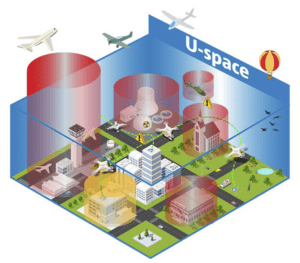A DRONELIFE exclusive: a team of experts outlines what EASA’s U-Space means for European drone operations.
The following is a guest post by Richard Hakes, Oliver Beiersdorf, and Julia Norsetter of global law firm Reed Smith’s Transportation Industry Group. DRONELIFE neither accepts nor makes payments for guest posts.
EASA’s U-Space: The future of air traffic management for drones and VTOL
The future of air mobility will include large numbers of unmanned aircraft flying in complex environments. Initially, unmanned operations started in rural areas to mitigate risk, but integration of these aircraft into congested airspace is needed to realize key social and environmental benefits.
Continue reading below, or listen:
Integration of unmanned aircraft into urban settings also requires sophisticated air traffic management. After all, an unmanned aircraft does not have a pilot on board to communicate with an air traffic controller about its flight plan and airspace risks.
The European Union, through its aviation safety authority (EASA) has taken measurable steps to address this traffic management challenge with the development of an unmanned traffic management system, called the “U-Space.” According to EASA, its U-Space framework will “enable a safe integration of drones and manned aircraft in Europe from 2023 [onwards].” This will be accomplished through the U-Space’s digital and automated services inside a designated volume of airspace.
Not all airspace in a given EU Member State will employ the U-Space framework. A Member State must designate a volume of airspace where the framework will be deployed. The U-Space will be especially beneficial for urban areas, where large numbers of manned and unmanned aircraft are expected to operate for myriad services, such as package delivery by drone and, eventually, the possibility of passenger carriage.
In January 2023, a European Commission Implementing Regulation went into effect, which is generally comprised of technical and operational requirements for the U-Space. These U-Space actors and their functions are highlighted briefly below.
- U-Space Service Supplier (USSP). The U-Space Service Provider will deliver specific information to unmanned aircraft within the U-Space. Essential services for USSPs include geospatial awareness, flight authorization, network identification and air traffic information. Optional services may include weather data. The USSP will also need to coordinate U-space services with existing air traffic management (“ANSP” below). Specific certification requirements will be set forth by EASA.
- EASA’s responsibilities under the U-Space concept include providing certification requirements and means of compliance for the USSPs, as well providing certification for some USSPs.
- Common Information Service (CIS) Supplier. The CIS is a fundamental central data backbone of the U-Space. This data backbone has a number of responsibilities, including data transmission with both USSPs and unmanned aircraft operators.
- Competent Authority. The Competent Authority of a Member State is often its Civil Aviation Authority (CAA). As discussed above, beginning in January 2023, Member States (and their CAAs) are now permitted to begin the process of defining airspace for U-Space services. This is an essential role for the Competent Authority, in addition to certifying USSPs based on EASA requirements, and ensuring a central authority for U-Space information coordination (Common Information Service Provider).
- Air Navigation Service Supplier. An ANSP is an entity, often government or private, which provides air traffic navigation services to existing, traditional aviation. In the U.S., this service is provided by FAA’s Air Traffic Control System. Under the U-Space concept, the ANSP’s responsibilities will include coordinating data with the USSPs, as well as dynamic reconfiguration of the airspace to permit multiple operations.
Requirements for U-Space actors
Specifications for U-Space operations and servicing entities are set forth in “acceptable means of compliance” (AMC) and guidance material (GM) issued in a decision by EASA in December 2022. For example, the AMC and GM will inform stakeholders, including Member States and potential service suppliers, as they seek approvals for use within the U-Space. Specific topics addressed within the AMC and GM include:
- For CIS, the operational functioning and the certification process
- For USSPs, the certification process and standards for the connection of CIS to USSPs
- For Member States, information relating to the risk assessment needed to designate U-Space, and Member State responsibilities
- For manned aircraft, acceptable means for conspicuously entering the U-Space
Current Options for Unmanned Aircraft Operations
The U-Space is still a developing framework with additional testing and evaluation before ubiquitous unmanned operations can occur. Nevertheless, UAS operators have the option of using the existing EASA drone regulatory framework for approval of diverse UAS operations (unrelated to U-Space). For example, certain operations beyond the visual line of sight of a UAS pilot-in-command may be approved using EASA’s risk assessment (SORA) to receive a risk score (SAIL) that will help in the approval process. This existing pathway may be a good first step for stakeholders seeking to familiarize themselves with EASA operational approval standards.
As it relates to new opportunities, EASA recently released a plan for its dissemination of regulations for high-risk operations for UAS and VTOL aircraft. The first tranche of information will likely address certain high-risk UAS operations and manned VTOL aircraft.
Read more:
- Europe’s U-Space Framework: Amit Ganjoo on The Drone Radio Show Podcast with Randy Goers
- France Chooses 8 UTM Providers to Create a “Best of Breed” Integrated Solution: “U-Space Together”
- The U-Space Deadline is January 2023. What Has to Happen Before That? A Conversation with ANRA’s Amit Ganjoo
- EASA High Level Conference on Drones: Drone Strategy Makes Europe “A Safe and Attractive Place” for Investment
Reed Smith’s global aviation team has decades of experience helping clients achieve their objectives and mitigate risks. The firm has a deep knowledge of the aviation industry and provides legal services to a broad spectrum of clients ranging from lenders, arrangers, lessors, leasing companies, and export credit agencies, to airlines, operators, aircraft and component part manufacturers, and aerospace and satellite companies.
 Richard Hakes is Chair of Reed Smith’s Transportation Industry Group. He is an asset finance partner, focusing on aviation and shipping. He advises clients in relation to a broad range of aviation and shipping work, with a primary focus on the financing, leasing, trading, and repackaging of transportation assets, acting for clients across the whole spectrum and life cycle of shipping and aviation deals.
Richard Hakes is Chair of Reed Smith’s Transportation Industry Group. He is an asset finance partner, focusing on aviation and shipping. He advises clients in relation to a broad range of aviation and shipping work, with a primary focus on the financing, leasing, trading, and repackaging of transportation assets, acting for clients across the whole spectrum and life cycle of shipping and aviation deals.
 Oliver Beiersdorf is the co-head of Reed Smith’s global Aviation and Aerospace group. His practice focuses on aviation, marine, commercial and product liability litigation. Oliver represents foreign and domestic airlines, product manufacturers and distributors, ship owners and operators, automobile manufacturers and other corporate clients in federal and state courts throughout the United States. Oliver has extensive experience in the areas of contract and insurance law, as well as international treaties, such as the Warsaw and Montreal Conventions, the New York Arbitration Convention, Death on the High Seas Act, Jones Act and Carriage of Goods by Sea Act.
Oliver Beiersdorf is the co-head of Reed Smith’s global Aviation and Aerospace group. His practice focuses on aviation, marine, commercial and product liability litigation. Oliver represents foreign and domestic airlines, product manufacturers and distributors, ship owners and operators, automobile manufacturers and other corporate clients in federal and state courts throughout the United States. Oliver has extensive experience in the areas of contract and insurance law, as well as international treaties, such as the Warsaw and Montreal Conventions, the New York Arbitration Convention, Death on the High Seas Act, Jones Act and Carriage of Goods by Sea Act.
 Julia Norsetter is Reed Smith’s Transportation Policy and Analysis Lead. Utilizing her in-depth industry knowledge and market analysis skills, she advises on sector and regulatory developments and plays an important role in helping develop and shape the firm’s transportation industry strategy. Her insight and industry analysis ensure that Reed Smith is at the forefront of industry developments and trends.
Julia Norsetter is Reed Smith’s Transportation Policy and Analysis Lead. Utilizing her in-depth industry knowledge and market analysis skills, she advises on sector and regulatory developments and plays an important role in helping develop and shape the firm’s transportation industry strategy. Her insight and industry analysis ensure that Reed Smith is at the forefront of industry developments and trends.

Miriam McNabb is the Editor-in-Chief of DRONELIFE and CEO of JobForDrones, a professional drone services marketplace, and a fascinated observer of the emerging drone industry and the regulatory environment for drones. Miriam has penned over 3,000 articles focused on the commercial drone space and is an international speaker and recognized figure in the industry. Miriam has a degree from the University of Chicago and over 20 years of experience in high tech sales and marketing for new technologies.
For drone industry consulting or writing, Email Miriam.
TWITTER:@spaldingbarker
Subscribe to DroneLife here.







[…] EASA’s U-Space: What it Indicates for European Drone Operations (DRONELIFE Exclusive) […]